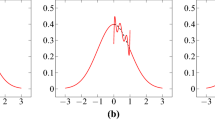Summary
It is well-known that for a large family of distributions, the sample midrange is asymptotically logistic. In this article, the logistic midrange is closely examined. Its distribution function is derived using Dixon's formula (Bailey (1935,Generalized Hypergeometric Series, Cambridge University Press, p. 13)) for the generalized hypergeometric function with unit argument, together with appropriate techniques for the inversion of (bilateral) Laplace transforms. Several relationships in distribution are established between the midrange and sample median of the logistic and Laplace random variables. Possible applications in testing for outliers are also discussed.
Similar content being viewed by others
References
Amemiya, T. (1980). Then −2-order mean squared errors of the maximum chi-square estimator,Ann. Statist.,8, 488–503.
Bailey, W. N. (1935).Generalized Hypergeometric Series, Cambridge University Press, London.
Berkson, J. (1944). Application of the logistic function to bio-assay,J. Amer. Statist. Ass.,39, 357–365.
Cox, D. R. (1970).Analysis of Binary Data, Methuen, London.
Galambos, J. (1978).The Asymptotic Theory of Extreme Order Statistics, Wiley, New York.
George, E. O. and Rousseau, C. C. (1986). A moment generating function, Problem 85-22 in Problems and Solutions,Soc. Industr. Appl. Math. (Review). (to appear).
Gumbel, E. J. (1944). Ranges and midranges,Ann. Math. Statist.,15, 414–422.
Karlin, S. (1968).Total Positivity, 1, Stanford University Press, Stanford, California.
Knuth, D. E. (1973).The Art of Computer Programming, 1, Fundamental Algorithms, Addison-Wesley, Reading, Massachusetts.
Pearl, R. and Reed, L. J. (1920). On the rate of growth of population of the United States since 1790 and its mathematical representation,Proc. Nat. Acad. Sci. USA,6, 275–288.
Plackett, R. L. (1959). The analysis of life test data,Technometrics,1, 9–19.
Verhulst, P. F. (1845). Recherches mathematiques sur la loi d'accroisement de la population,Nouveaux memoirs de l'ac Bruxelles,18, 1–38.
Author information
Authors and Affiliations
About this article
Cite this article
George, E.O., Rousseau, C.C. On the logistic midrange. Ann Inst Stat Math 39, 627–635 (1987). https://doi.org/10.1007/BF02491495
Received:
Revised:
Published:
Issue Date:
DOI: https://doi.org/10.1007/BF02491495



